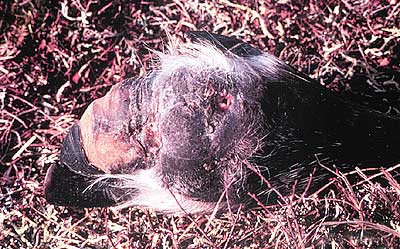Parasites and Diseases
Hoofrot
A Field Guide
TO COMMON WILDLIFE DISEASES
AND PARASITES IN ALASKA
HOOFROT

Swollen caribou hoof with hoofrot.
| What causes hoofrot? |
- This disease is caused by the bacterium known as Spherophorous necrophorous.
- This bacterium is a normal inhabitant of the soil. It can also be found in the mouth and intestinal tract of many species of animals.
- The bacteria often enter a susceptible host through a break in the skin directly above the hoof.
| Where does hoofrot occur? |
- Caribou and reindeer are the most common hosts of hoofrot infection.
- This disease can occur in any caribou herd. During the late 1990s, it was observed in the Mulchatna and Western Arctic herds.
- Outbreaks of disease are most common and most severe during periods of extended rainy weather.
| What are the signs of hoofrot? |
- Abscesses form directly above the hoof. The hoof may swell 2 – 3 times its normal size. The abscess contains thick, foul-smelling pus.
- Infected caribou often limp.
- Abscesses may also be found in other locations, such as the liver, lungs or mouth.
| How can I protect myself? |
- People are theoretically susceptible to infection. However, there have never been any human cases of this disease reported in Alaska.
- Humans should avoid direct contact with pus-filled abscesses.
- If possible, wear rubber gloves when butchering a caribou with abscesses on the hooves.
| Can I eat the meat? |
|
- The meat of caribou with hoofrot is safe to eat.
- Discard the infected leg. Cook the remainder of the meat thoroughly.
| Samples to collect |
- Remove the lower leg at the first joint. Place it in a plastic bag and keep cool.
- To report an occurrence or to submit a sample for identification/analysis, contact the DWC Wildlife Disease Surveillance reporting hotline 907-328-8354, send an email to dfg.dwc.vet@alaska.gov or visit your local ADF&G office.
